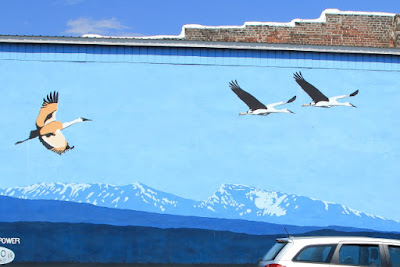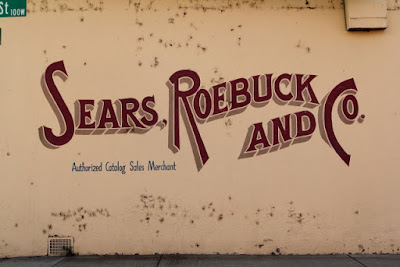Tonopah (population 2,478) is located about half way between Las Vegas and Reno and was historically known as "Queen of the Silver Camps."
The community was founded in the 1900s when a prospector's burro wandered away during the night and the next morning the prospector found the burro standing near a rock outcropping. In frustration, the prospector picked up a rock to throw at the burro and he noticed that the rock was unusually heavy. It turns out that the burro had found the second-richest silver deposit in the history of Nevada.
However, by 1910, the mines begin to playout and the population of Tonopah started declining until only a few business were left open. The town currently relies heavily on income from the military Tonopah Test Range that is located nearby.
The most famous person from Tonopah is probably Hugh Bradner, physicist, and inventor of the neoprene wetsuit that helped revolutionize SCUBA diving.
The Clown Motel contains over 600 clowns of all types. There are clowns on doors, shelves, painted on walls, and any other place possible. However, many people say the motel is haunted. There is a cemetery adjacent to the property that is filled with miners that died unpleasant and horrible deaths. Although not confirmed, some say the motel is built on old graves. Anyway, the motel is for sale if you are an entrepreneur looking for a new business.
There are two interesting museums in town -- the Central Nevada Museum and the Tonopah Historic Mining Park.
The Central Nevada Historical Society was formed to preserve the history of Nye and Esmeralda Counties. There are a number of mining, ranching and wild west displays, along with a research library that includes information on early pioneers in the area. On three different occasions the museum has been the recipient of the "Best of Nevada" award and most recently the museum received the Trip Advisors Certificate of Excellence.
 |
| File Picture |
 |
| File Picture |
 |
| File Picture |
The museum explored the possibility of offering underground tours of the original mine, but an inspection of the mine revealed that the tunnels were too unstable and it would not be financially feasible to bring in all of the stabilization reinforcement that would be required to meet safety requirements. Instead, an underground tunnel has been constructed that intersects one of the original discovery slopes and visitors are able to walk to the end of the tunnel and look down the 500 foot deep slope.
All of the buildings located on the property are open to the public on a self-guided tour basis, along with many outside exhibits.
 |
 |
| File Picture |
 |
| File Picture |
 |
| File Picture |
 |
| File Picture |
 |
| File Picture |
 |
| File Picture |
 |
| File Picture |
 |
| File Picture |
The Ammunition Depot at Hawthorne was opened after a 1926 fire at the ammunition depot in Lake Denmark, New Jersey, caused a large explosion that destroyed the town, killed over 50 people, and injured hundreds more. The military then decided that the ammunition deport should be located in a more remote location of the United States and away from major population centers. Thus, Hawthorne (current population 3,269) was selected for the new depot and is currently the county seat of Mineral County (population 4,772). Mineral County is the fourth-least populous county in Nevada with a density of 1.3 people per square mile.
Yerington (population 3,048) is the current county seat for Lyon County. The county seat was originally established in Dayton in 1861, but after the courthouse burned down the county seat was moved to Yerington in 1911.
During WW II one of the Japanese Fire Balloons landed on a ranch near Yerington. However, the rancher did not know what it was, so he cut the balloon up and used it as a hay tarp.
The Lyon County Museum is located in the historic Community Church that was constructed in Mason in 1911 and then moved to Yerington in 1930, to become the Seventh Day Adventist Church. In 1976, as part of the United States Bicentennial Celebration, negotiations started to purchase the building for a museum and the sale was finalized in 1978. Since that time there have been several expansions so that additional historic buildings could be relocated to the site. The museum now incorporates three one-room schoolhouses, a general store, a blacksmith shop and a gas station.
Although difficult to read, lettering on the arch states "Gateway to Jeanne Dini Cultural Center." The center is a multi-use building for providing arts and cultural events in Yerington and can also be rented for conferences, receptions, retreats, meetings, reunions and other special events.
In 1860 Samuel Buckland built a large log cabin along the California Trail where it crossed the Carson River and set up an Overland Stage Company Station that was also used as a remount station along the Pony Express Route. He also built a "tent hotel" for traveling guest and then in 1864 he expanded his enterprise and opened a general store. In later years he built the existing two-story house using salvage materials he obtained from the dismantling of Fort Churchill.
Reno, "The Biggest Little City in the World," is always a nice place to stay. When I had a full-time job I traveled to Reno often and typically stayed by the airport or at one of the downtown hotel/casinos; so this time I decided to stay at one of the hotel/casinos located out in the suburbs. When I checked in I somehow managed to get upgraded to one of the high-roller suites on the second-to-top floor, which made the stay even more enjoyable. In the morning as we were driving out of Reno, from the highway we were able to see a large balloon liftoff with many beautiful balloons.
The California State line is a short distance from Reno and just after crossing the state line I saw a beautiful "shoe tree" near the side of the road that was in full bloom.
Susanville (population 17,947) is the county seat of Lassen County, California, and nearly half of the adult population of Susanvills works at one of the three prisons in the area. Although the Southern Pacific Railroad no longer serves Susanville, a Union Pacific Railroad Caboose is located across the street from the historic depot. (No explanation was provided that would indicate why the caboose was from the Union Pacific Line.)
A few miles north of Susanville there is a Noble Emigrant Trail maker where the Trail crossed what is now US Highway 395. The Trail was first used in 1852 by emigrants seeking to avoid the Lassen Trail hardships as it crossed the desert from the Humboldt River (Nevada) to Shasta (California).
There is not much remaining in Madeline (California) and with the exception of a few families, the the town is close to becoming a ghost town. At one time Madeline was an important stop on the Nevada-California-Oregon Railroad and a major livestock shipping center. The old water tower still stands adjacent to U.S. Highway 395 as a reminder of days-gone-by.
Likely (population 63) was originally named South Fork, but as the community grew a post office could not be opened because at that time post offices could only have one-word names. The residents could not reach an agreement on a one-word name and then a rancher finally said: "We most likely ain't never gona agree upon a name," and at that point the name "Likely" was agreed upon and the post office opened in 1878.
Alturas (population 2,827) is the county seat of Modoc County, California. The town is located on a historic Achumawi Indian Village site that was known as Kosealekte (aka Kasalektawi). There are a number of historic buildings in the downtown area that have interesting murals and other paintings on the buildings' exterior walls.
On January 10, 1945 a WW II Japanese Balloon Bomb was shot down near Alturas, but the bomb did not do any damage to buildings or people.
New Pine Creek (population 98) is located on the northern boundary line of Modoc County is the northernmost settlement in the State of California.
On to Oregon and Washington!






































No comments:
Post a Comment